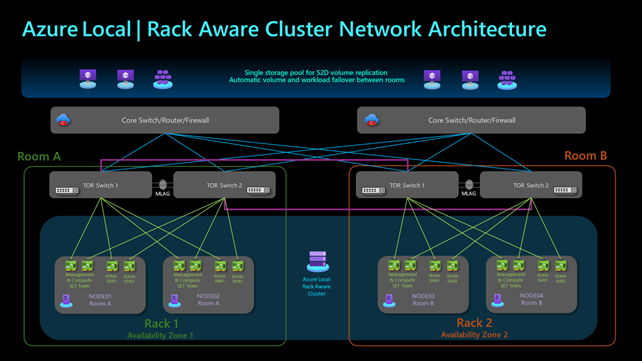Azure Local now offers even more resiliency with the introduction of Rack Aware clusters. We’ll discuss what a Rack Aware cluster is in more detail below, and this blog is aimed at showing how to deploy a Rack Aware cluster from the Azure Portal.
Rack Aware clusters have been in private preview until recently, and initially the only way to deploy them was via an ARM Template. With Azure Local version 2510, Rack Aware clusters are now in public preview and Microsoft has introduced the ability to deploy Rack Aware clusters using the Azure Portal.
What is a Rack Aware Cluster?
Rack Aware Cluster is a new cluster option which spans two separate racks or rooms within the same Layer-2 network at a single location, such as a manufacturing plant or a campus. Each rack functions as a local availability zone across layers from OS to Arc management including Arc VMs and AKS enabled by Azure Arc, providing fault isolation and workload placement within the cluster. The solution is configured with one storage pool to reduce additional storage replication and enhance storage efficiency. This solution delivers the same Azure deployment and management experience as a standard cluster. This setup is suitable for edge locations and can scale up to 8 nodes, with 4 nodes in each rack.

Main Design Considerations
- Data drives must be all-flash. Either Nonvolatile Memory Express (NVMe) or solid-state drives (SSD) work. No Hybrid configs (Cache+HDD).
- Only new deployments are supported. Conversion from standard clusters deployments to rack aware clusters isn’t supported.
- Round-trip latency between racks must be 1 millisecond or less.
- You can’t create 3-way mirror volumes. Only 2-way or 4-way mirror volumes are supported.
- You can scale the cluster by adding a pair of nodes to a rack aware cluster. The 2+2 configuration can be expanded to 3+3, and 3+3 to 4+4. However, adding nodes to a 1+1 rack aware cluster isn’t supported in this release.
- You can go from Public Preview to General available without re-deployment.
- For 2+2 and larger rack aware cluster configurations, deployment via the Azure portal supports only Express mode. In this mode, infrastructure components, workload volumes, and storage paths are automatically created for each volume. (And thin provisioning is enabled!)
- For AKS nodes in Rack Aware Clustering there has been published additional guidance in this preview: Spread Azure Kubernetes Service (AKS) nodes in rack aware cluster (Preview) – Azure Local | Microsoft Learn
Portal Deployment
The cloud deployment of Rack Aware clusters via the portal is very similar to the normal deployment process of Azure Local instances, with some specific configuration nuances. I will highlight the differences below rather than show the full end-to-end experience.
Please ensure the prerequisites have been met as per the documentation:
Prepare to deploy rack aware cluster via the Azure portal (Preview) – Azure Local | Microsoft Learn
Once the nodes are Arc registered, then deployment configuration can begin, as per the below example:
In the Basics section, select ‘Rack aware cluster‘:

Add and validate the nodes, ensure there are an even number:

Wait for the nodes to validate and the Extensions to install.


Select or add a new Key vault:

Select the configuration settings:

In the Networking section, select the pattern and configure your Intents, example below (for Rack Aware it must be a switched storage design):






Configure your management settings, example below:
A cluster witness is required for rack aware cluster. Select an existing Storage account or create a new Storage account to store the cloud witness file.

Select the security settings:

Key Section for Rack Aware
In the Advanced section, configure the zone settings and associate nodes with zones, examples below:



Validate the instance before deployment:

Review the configuration settings and then create and deploy the instance:


After deployment, the nodes are configured with the Rack fault domain:

Conclusion
I hope you find this article is useful in deploying a Rack Aware cluster. Rack Aware is going to become an important design option for datacenter deployments where companies want the extra resilience at the rack or room level. Azure Local is already a highly resilient solution and Rack Aware shows Microsoft’s commitment to innovation to provide the a leading class of service.
As ever, please review the official documentation for more details:
https://learn.microsoft.com/en-us/azure/azure-local/deploy/rack-aware-cluster-deploy-portal
Post Disclaimer
The information contained in the posts in this blog site is for general information purposes only. The information in this post "Deploy an Azure Local Rack Aware Cluster via the Azure Portal" is provided by "Lee Harrison's Technical Blog" and whilst we endeavour to keep the information up to date and correct, we make no representations or warranties of any kind, express or implied, about the completeness, accuracy, reliability, suitability or availability with respect to the website or the information, products, services, or related graphics contained on the post for any purpose. Furthermore, it is always recommended that you test any related changes to your environments on non-production systems and always have a robust backup strategy in place.